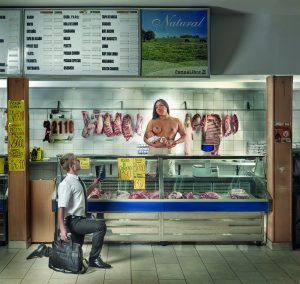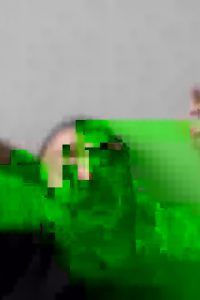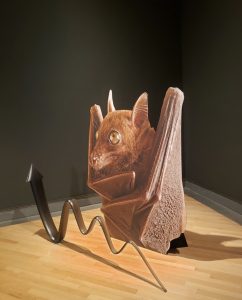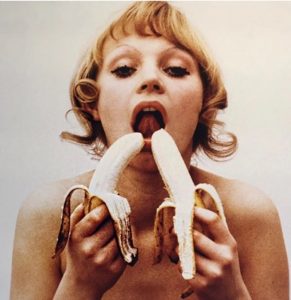I’m not sure how much i can cover from Transmediale this year since i could only attended the two first days, missing the crowd, the friends and some of the most exciting performances and presentations of the long weekend. I can tell you something about the seven transmediale Award nominees though. They were as different from each other as it is humanely possible and that’s a sight i always welcome in a festival.
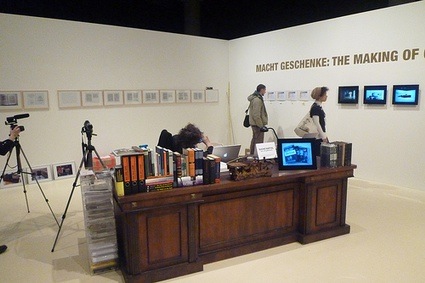 View of the project in exhibition space
View of the project in exhibition space
I didn’t have a clear favourite this year but MACHT GESCHENKE: Das Kapital – Kritik der Politischen Ökonomie had the merit of making me smile.
Every single day since 25 May 2009, Christin Lahr is giving 1 cent to the German Federal Ministry of Finance via an online bank transfer. She fills in the 108 characters of the ‘reason for payment’ box with a few words from Karl Marx’s CAPITAL – A Critique of Political Economy. It will take 43 years and 15 709 cents to transcribe the 1 696 500 characters of the book.
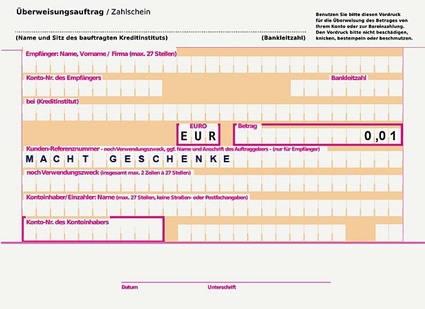 CAPITAL PRESENTS, money transfer form, 1 Cent
CAPITAL PRESENTS, money transfer form, 1 Cent
The increase in capital value by interest rates, the amount of work, life duration and cultural and symbolic capital have not been taken into account. The work is Lahr’s gift to the people, appointed to the budget of the Federal Republic of Germany, securely kept in the archive and administrated by voted representatives.
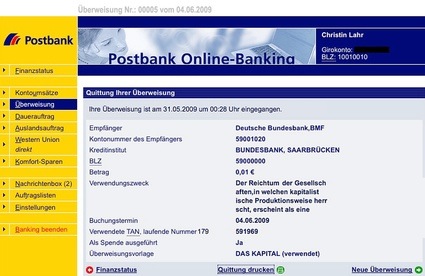 Screenshot of a money transfer
Screenshot of a money transfer
If it were possible to freeze the present German financial deficit of € 1 746 599 197 210, Lahr’s gift would cancel out this amount in approximately 300 years due to the exponential effects of inflation and compound interest rates.
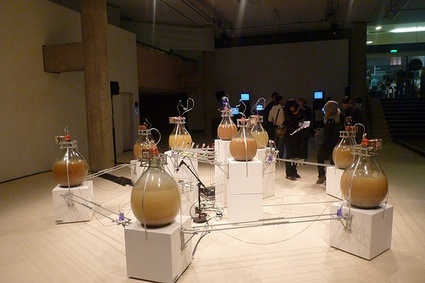
Lahr’s project received a Distinction from the jury. The winning project was Intelligent Bacteria – Saccharomyces cerevisiae, an acoustic and performative installation but also a research project developed by HONF – The House Of Natural Fiber in collaboration with scientists from the Gadjah Mada University (UGM) in Indonesia. The work explores the field of microbiology and biotechnology from an art and science perspective, using DIY and open source technologies.
Intelligent Bacteria – Saccharomyces cerevisiae borrows part of its name from a species of budding yeast used since ancient times in brewing. Alcohol is indeed at the heart of the project. Because the consumption of alcohol is forbidden by religion in the country and its price has sharply increased last Spring due to a new governmental regulation, Indonesians have started to produce their own booze. However, most people have little understanding of the proper fermentation process and many have died or been poisoned in their attempt to make alcohol.
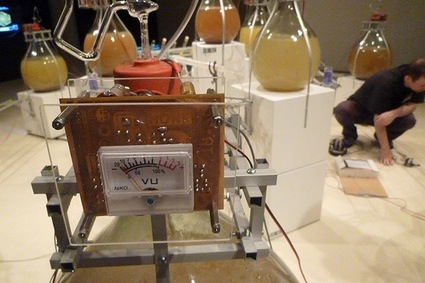
HONF teamed with the UGM researchers to develop and distribute a nontoxic fermentation technology that anyone can try at home. They hope that their method will be used by Indonesians to produce alcohol that is both affordable and safe for consumption. The group even had a bacteria performance on the closing night of the festival but as hinted above, i couldn’t be there.
Another nominated work i need to mention is Scott Kildall and Nathaniel Stern‘s Wikipedia Art. The conceptual work was launched two years ago on Wikipedia as a conventional Wikipedia page, requiring thus art editors to abide by Wikipedia’s standards of quality and verifiability, Any changes to the art had therefore to be published on, and cited from, ‘credible’ external sources from ‘trustworthy’ media outlets. Wikipedia Art blossomed this as a collaborative performance that kept on transforming itself through its editors discussions.
15 hours after its creation the page was deleted. Jimmy Wales called Kildall a troll. The artists were sued for trademark infringement by the Wikipedia Foundation, when they set up wikipediaart.org to archive their project.
The art world was not so supercilious. The project was even included in the Internet Pavilion of the Venice Biennale for 2009. In an interview to myartspace the author of the project explained that “one of the problems we discovered is that a huge demographic of very young people (ages 16-23) dominates the Wikipedia culture, ethos and information trade. The result is a bigger emphasis on pop culture and esoteric geek factoids, while topics like art movements and artists get sidelined. Try looking up something like “Warlock (Dungeons & Dragons)” as compared to, say, digital art star Cory Arcangel, who is currently on the cover of Art Forum. The standards for the two are completely opposing! The D&D page only uses online sources far from the mainstream, while the Cory Arcangel page references some of the most important museums in existence today. Despite this, the D&D page actually calls for “expansion,” while the Arcangel page is prefaced with a disclaimer that its citations are insufficient.”

